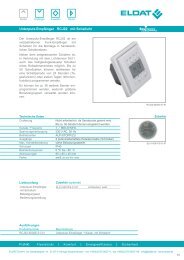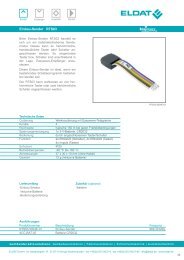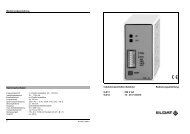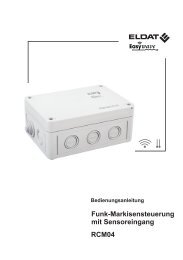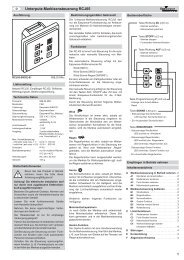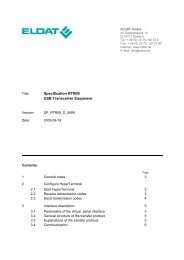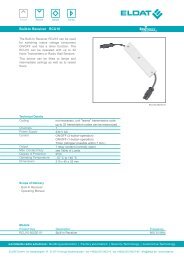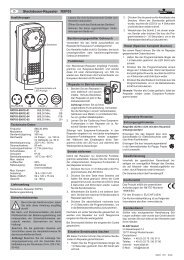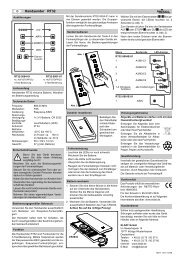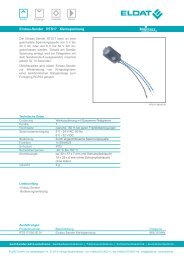Specification of RTRM08 Transceiver Module Easywave I2C - ELDAT
Specification of RTRM08 Transceiver Module Easywave I2C - ELDAT
Specification of RTRM08 Transceiver Module Easywave I2C - ELDAT
You also want an ePaper? Increase the reach of your titles
YUMPU automatically turns print PDFs into web optimized ePapers that Google loves.
<strong>Specification</strong><br />
Index 1.01<br />
Project No.<br />
RF-Products, Controller <strong>RTRM08</strong> <strong>Transceiver</strong> <strong>Module</strong> Easw I 2 C Page 12<br />
Development<br />
Production S. Schreiber 2007-08-24<br />
addressing a slave<br />
(high part <strong>of</strong> address)<br />
addressing a slave<br />
(low part <strong>of</strong> address)<br />
2-bit 0 0 8-bit 0<br />
free S 11110 address RW A+ Sr address A+<br />
write transfer<br />
8-bit 0 8-bit 0/1<br />
data byte A+ data byte A<br />
addressing the slave for read<br />
transfer (high part <strong>of</strong> address)<br />
2-bit 1 0 8-bit 0 8-bit 1<br />
Sr 11110 address RW A+ data byte A+ data byte A- P free<br />
from master to slave<br />
from slave to master<br />
read transfer<br />
Figure 8 Combined write and read transfer using a 10-bit address<br />
Accessing the <strong>Transceiver</strong> <strong>Module</strong><br />
S start condition<br />
Sr repeated start condition<br />
RW R/W direction bit<br />
A+ acknowledge-bit (SDA line is low)<br />
A- acknowledge-bit (SDA line is high)<br />
A acknowledge-bit (SDA line is low or high)<br />
P stop condition<br />
The transceiver module is a slave and has a fixed I 2 C address (7-bit), which is 1100010 (binary, excluding<br />
the R/W-bit). Other fixed I 2 C addresses (7-bit or 10-bit) are available on request.<br />
The module holds all information in registers which can be written or read via the I 2 C-interface. Each register<br />
is 8 bits wide (one byte) and has a specific register address. The register address also is 8 bits wide.<br />
The module maintains a register address pointer, which contains the register address <strong>of</strong> the register that is<br />
written or read at next.<br />
When a master does a write transfer to the transceiver module, the module takes the first data byte <strong>of</strong> the<br />
transfer as desired register address: it initializes its register address pointer with the transferred data byte<br />
(Figure 9). Each subsequently transferred data byte is written into the register which the current register<br />
address pointer specifies. The register address pointer is incremented by one after each write, so the next<br />
transferred data byte is written into the next register.<br />
When a master does a read transfer from the transceiver module, each data byte is read out <strong>of</strong> the register<br />
7007



